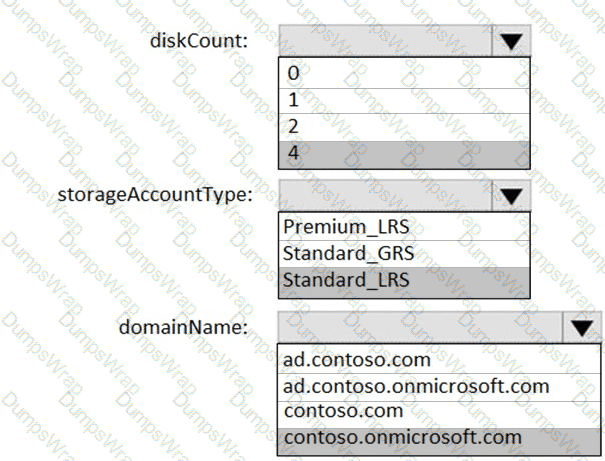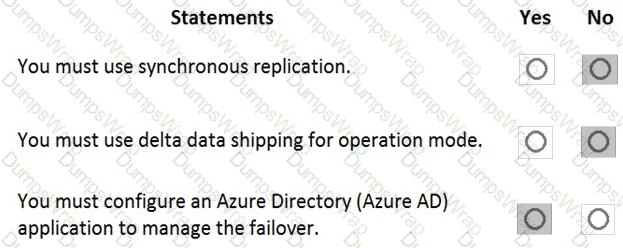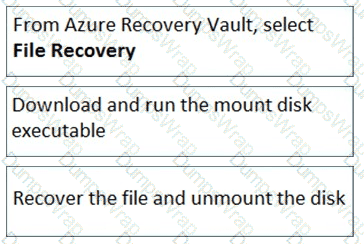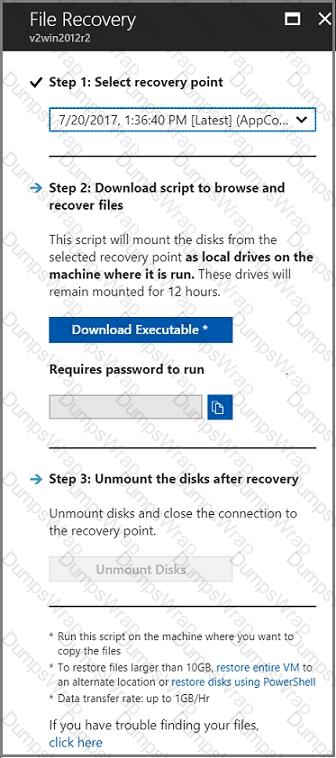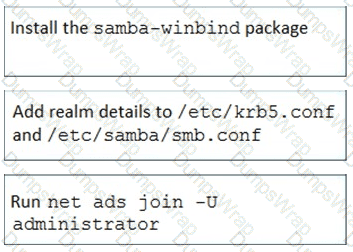Planning and Administering Microsoft Azure for SAP Workloads Questions and Answers
You need to provide the Azure administrator with the values to complete the Azure Resource Manager template.
Which values should you provide for diskCount, StorageAccountType, and domainName? To answer, select the appropriate options in the answer area.
NOTE: Each correct selection is worth one point.
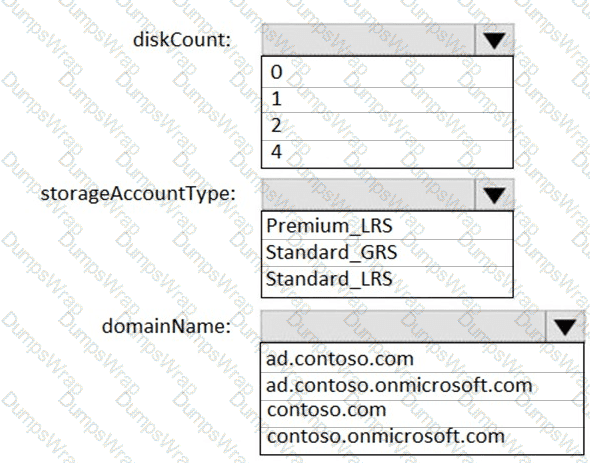
Before putting the SAP environment on Azure into production, which command should you run to ensure that the virtual machine disks meet the business requirements? To answer, select the appropriate options in the answer area.
NOTE: Each correct selection is worth one point.

This question requires that you evaluate the underlined BOLD text to determine if it is correct.
You are planning for the administration of resources in Azure.
To meet the technical requirements, you must first implement Active Directory Federation Services (AD FS).
Instructions: Review the underlined text. If it makes the statement correct, select “No change is needed”. If the statement is incorrect, select the answer choice that makes the statement correct.
Once the migrate completes, to which size should you set the ExpressRoute circuit to the New York office to meet the business goals and technical requirements?
You are planning the Azure network infrastructure to support the disaster recovery requirements.
What is the minimum number of virtual networks required for the SAP deployed?
Which Azure service should you deploy for the approval process to meet the technical requirements?
You are evaluating the proposed backup policy.
For each of the following statements, select Yes if the statement is true. otherwise, select No.
NOTE: Each correct selection is worth one point.
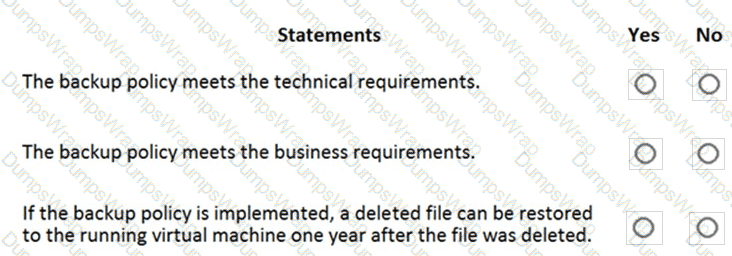
You are planning replication of the SAP HANA database for the disaster recovery environment in Azure.
For each of the following statements, select Yes if the statement is true. Otherwise, select No.
NOTE: Each correct selection is worth one point.
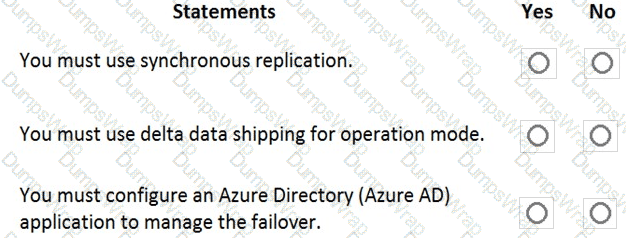
You need to recommend a solution to reduce the cost of the SAP non-production landscapes after the migration.
What should you include in the recommendation?
For each of the following statements, select Yes if the statement is true. Otherwise, select No.
NOTE: Each correct selection is worth one point.

What should you use to perform load testing as part of the migration plan?
For each of the following statements, select Yes if the statement is true. Otherwise, select No.
NOTE: Each correct selection is worth one point.

You are evaluating the migration plan.
Licensing for which SAP product can be affected by changing the size of the virtual machines?
You are evaluating which migration method Litware can implement based on the current environment and the business goals.
Which migration method will cause the least amount of downtime?
You need to ensure that you can receive technical support to meet the technical requirements.
What should you deploy to Azure?
Litware is evaluating whether to add high availability after the migration?
What should you recommend to meet the technical requirements?
You have an SAP environment on Azure.
You use Azure Recovery Services to back up an SAP application server.
You need to test the restoration process of a file on the server.
Which three actions should you perform in sequence? To answer, move the appropriate actions from the list of actions to the answer area and arrange them in the correct order.
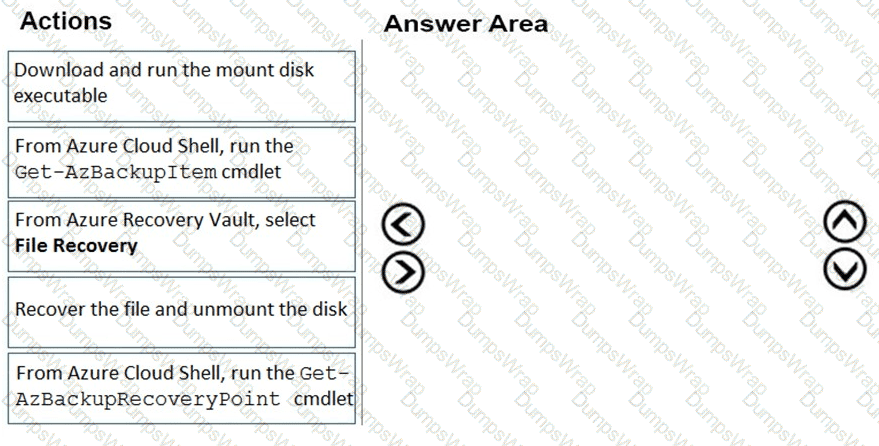
You have a SUSE Linux Enterprise Server (SLES) duster that runs SAP HANA.
You plan to use Azure Monitor for SAP Solutions to collect STONITH block device (SBD) metrics from the cluster.
Which provider should you use. and what should you install on each cluster node? To answer, select the appropriate options in the answer area.
NOTE: Each correct selection is worth one point.

Note: This question is part of a series of questions that present the same scenario. Each question in the series contains a unique solution that might meet the stated goals. Some question sets might have more than one correct solution, while others might not have a correct solution.
After you answer a question in this section, you will NOT be able to return to it. As a result, these questions will not appear in the review screen.
You deploy SAP HANA on Azure (Large Instances).
You need to back up the SAP HANA database to Azure.
Solution: Back up directly to disk, copy the backups to an Azure virtual machine, and then copy the backup to an Azure Storage account
Does this meet the goal?
You deploy an SAP environment on Azure by following the SAP workload on Azure planning and deployment
checklist.
You need to verify whether Azure Diagnostics is enabled.
Which cmdlet should you run?
Note: This section contains one or more sets of questions with the same scenario and problem. Each question presents a unique solution to the problem. You must determine whether the solution meets the stated goals. More than one solution in the set might solve the problem. It is also possible that none of the solutions in the set solve the problem.
After you answer a question in this section, you will NOT be able to return. As a result, these questions do not appear on the Review Screen.
You have an on-premises datacenter.
You have an Azure subscription that contains a virtual network named VNet1.
You have an SAP RISE managed workload.
You need to ensure transitive connectivity between the datacenter. VNet1, and the managed workload.
Solution: You configure a Site-to-Site (S2S) VPN connection between the datacenter and the managed workload and virtual network peering between VNet1 and the managed workload.
Does this meet the goal?
You have an SAP environment on Azure.
Your on premises network uses a 1 Gbps ExpressRoute circuit to connect to Azure. Private peering is enabled on the circuit. The default route (0.0.0.0/0) from the on-premises network is advertised.
Whenever backups are copied to Azure Blob storage, the ExpressRoute circuit is saturated.
You need to resolve the issue without modifying the ExpressRoute circuit. The solution must minimize administrative effort.
What should you do?
You have an Azure subscription named Sub1 that contains a Microsoft Sentinel workspace named Workspace1.
You have an SAP RISE managed workload that is integrated with Sub1.
You implement the Microsoft Sentinel solution for SAP applications in Workspace1.
You need to deploy the Microsoft Sentinel for SAP connector for Workspace1 by using the Azure portal.
What should you provision first?
You have an SAP on Azure landscape.
You configure SAP Central Services (SCS) to write logs to Windows Event Viewer.
You need to collect the logs in Azure Monitor by using a Data Collection Rule (DCR). The solution must prevent the logs from being sent via the internet.
Which two resources should you configure? Each correct answer presents part of the solution.
NOTE: Each correct selection is worth one point.
Your on-premises network contains an Active Directory domain.
You have an SAP environment on Azure that runs on SUSE Linux Enterprise Server (SLES) servers.
You configure the SLES servers to use domain controllers as their NTP servers and their DNS servers.
You need to join the SLES servers to the Active Directory domain.
Which three actions should you perform in sequence? To answer, move the appropriate actions from the list of actions to the answer area and arrange them in the correct order.
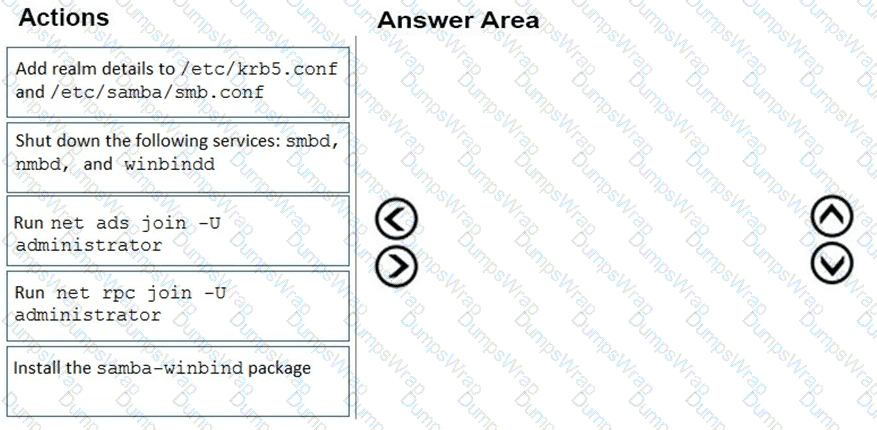
You have an SAP landscape on Azure that contains the virtual machines shown in the following table.

You need to recommend a recovery solution in the event of an Azure regional outage. The solution must meet the following requirements:
• Minimize costs.
• Minimize data loss.
• Minimize administrative effort.
What should you recommend for each virtual machine? To answer, drag the appropriate services to the correct virtual machines. Each service may be used once, more than once, or not at all. You may need to drag the split bar between panes or scroll to view content.
NOTE: Each correct selection is worth one point.

Note: This question is part of a series of questions that present the same scenario. Each question in the series contains a unique solution that might meet the stated goals. Some question sets might have more than one correct solution, while others might not have a correct solution.
After you answer a question in this section, you will NOT be able to return to it. As a result, these questions will not appear in the review screen.
You have an SAP production landscape on-premises and an SAP development landscape on Azure.
You deploy a network virtual appliance to act as a firewall between the Azure subnets and the on-premises network.
You need to ensure that all traffic is routed through the network virtual appliance.
Solution: You create an Azure Traffic Manager profile.
Does this meet the goal?
You plan to migrate an SAP environment to Azure.
You need to recommend a solution to migrate the SAP application servers to Azure. The solution must
minimize downtime and changes to the environments.
What should you include in the recommendation?
You have an SAP ERP Central Component (SAP ECO deployment on Azure virtual machines. The virtual machines run Windows Server 2022 and are members of an Active Directory domain named contoso.com.
You install SAP GUI on an Azure virtual machine named VM1 that runs Windows 10.
You need to ensure that contoso.com users can sign in to SAP ECC via SAP GUI on VM1 by using their domain credentials.
What should you do? To answer, drag the appropriate components to the correct tasks. Each component may be used once, more than once, or not at all. You may need to drag the split bar between panes or scroll to view content.

You migrate an SAP environment to Azure.
You need to inspect all the outbound traffic from the SAP application servers to the Internet.
Which two Azure resources should you use? Each correct answer presents part of the solution.
Network Performance Monitor
You have an SAP production landscape in Azure.
Users access the landscape from the internet by using Azure Application Gateway.
You need to analyze the network traffic of the landscape by using Azure Network Watcher traffic analytics.
What should you configure?


